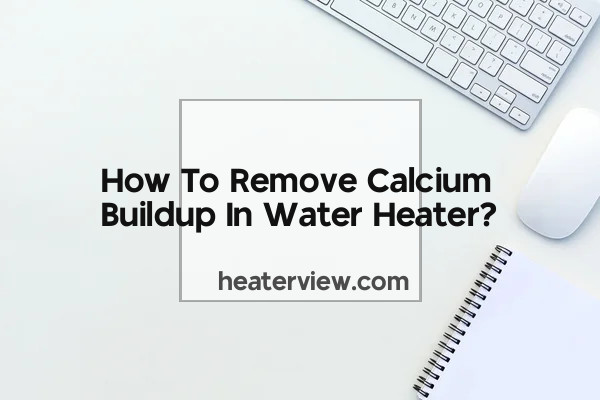If your water heater has been in use for a while, it’s likely that some calcium buildup has occurred on the heating elements. This isn’t a serious problem, but it can lead to reduced efficiency and increased energy costs. Luckily, there are a few simple ways to remove this buildup.
One way is to use a vinegar and water solution. Simply mix equal parts vinegar and water, and then use a brush to scrub away the calcium deposits. If the vinegar smell is too strong for you, you can also add a few drops of essential oil to the mixture.
Another option is to use a commercial descaling solution. These are designed specifically to remove calcium buildup, and you can find them at most hardware stores. Be sure to follow the instructions on the package, as some of these solutions can be corrosive.
If you have a lot of calcium buildup, you may need to descale your water heater more than once. However, following these simple tips should help keep your water heater running efficiently for many years to come.
What Is The Best Way To Remove Calcium Buildup In A Water Heater?

If you have hard water, there’s a good chance that over time you’ll notice a white, chalky substance on your fixtures and in your plumbing. This is calcium carbonate, and it’s harmless—except when it starts to build up in your water heater.
Calcium carbonate is insoluble, so it doesn’t pose a health risk. But it can cause your water heater to work less efficiently and, eventually, fail prematurely.
Fortunately, there are a few things you can do to remove calcium carbonate buildup from your water heater:
1. Flush your water heater.
This is the simplest and most effective way to remove calcium carbonate buildup. Just open the drain valve at the bottom of your water heater and let the water flow out until it runs clear.
2. Use a vinegar solution.
If flushing your water heater doesn’t do the trick, you can try a vinegar solution. Just mix equal parts water and vinegar in a bucket and pour it into the water heater through the open drain valve.
Let the solution sit for an hour, then flush the water heater again.
3. Use a commercial descaling solution.
If you still have calcium carbonate buildup after flushing and using a vinegar solution, you can try a commercial descaling solution.
Follow the instructions on the package, but generally, you’ll mix the solution with water and pour it into the water heater. Let it sit for the recommended time, then flush the water heater again.
4. Call a plumber.
If you’ve tried all of the above and you still have calcium carbonate buildup, it’s time to call a plumber. They have specialized equipment that can remove stubborn calcium carbonate buildup.
Now that you know how to remove calcium carbonate buildup from your water heater, you can keep your water heater running smoothly for years to come.
How Do You Remove Calcium Buildup In A Water Heater?
If your water heater is starting to show signs of calcium buildup, it’s important to take care of the problem as soon as possible. Calcium buildup can cause a number of problems, including decreased efficiency and, in extreme cases, leaks.
There are a few different ways to remove calcium buildup from a water heater, but the most effective method is to use a vinegar and water solution. To do this, simply mix equal parts vinegar and water and pour the mixture into the water heater. Let the solution sit for a few hours, then flush the heater with clean water.
If you have a severe calcium buildup, you may need to repeat this process a few times. You can also use a commercial calcium remover, but be sure to follow the instructions carefully.
If you have hard water, you can help prevent calcium buildup in your water heater by installing a water softener. This will remove the minerals from the water before they have a chance to build up on the heater. You can also periodically flush the heater with clean water to help remove any buildup that has already occurred.
What Are The Consequences Of Not Removing Calcium Buildup In A Water Heater?
If you don’t remove calcium buildup from your water heater, it will eventually become so clogged that it won’t be able to function properly. This can lead to a number of consequences, such as:
-Your water heater will have to work harder to heat up the water, which can lead to higher energy bills.
-The water heater may eventually stop working altogether, leaving you without hot water.
-If the water heater breaks down, it can be expensive to repair or replace.
So, it’s important to remove calcium buildup from your water heater on a regular basis to avoid these consequences.
How Often Should You Remove Calcium Buildup In A Water Heater?
If your water heater is starting to show signs of calcium buildup, it’s important to take care of the problem right away. Left unchecked, calcium buildup can lead to a number of problems, including decreased efficiency, premature corrosion, and even complete failure of the unit.
So
How often should you remove calcium buildup from a water heater?
The answer may surprise you…
It’s actually not necessary to remove calcium buildup from a water heater on a regular basis. In fact, most experts recommend only doing so if the buildup is causing problems or if it’s been more than five years since the last time the unit was serviced.
Of course, if you do notice any problems with your water heater, it’s always best to call a professional for help. They’ll be able to quickly assess the situation and determine the best course of action.
In most cases, removing calcium buildup from a water heater is a fairly simple process. A professional technician will likely use a special solution to dissolve the calcium, and then flush the unit with clean water to remove any residual buildup.
If you think your water heater might have a problem with calcium buildup, don’t wait to get it checked out. Call a professional today, and be sure to ask about having the unit serviced every five years or so to prevent future problems.
Hopefully, you are clear now on how to remove calcium buildup in water heaters. If you still have any questions, feel free to comment below.


